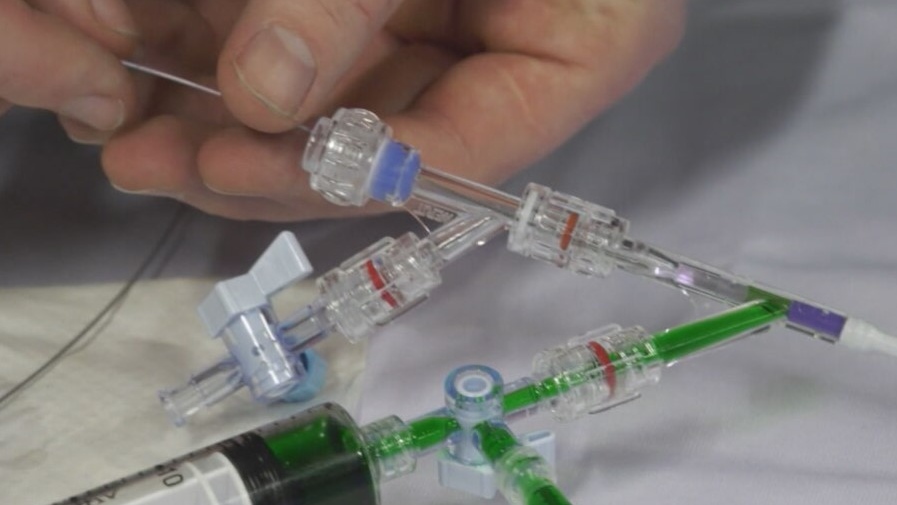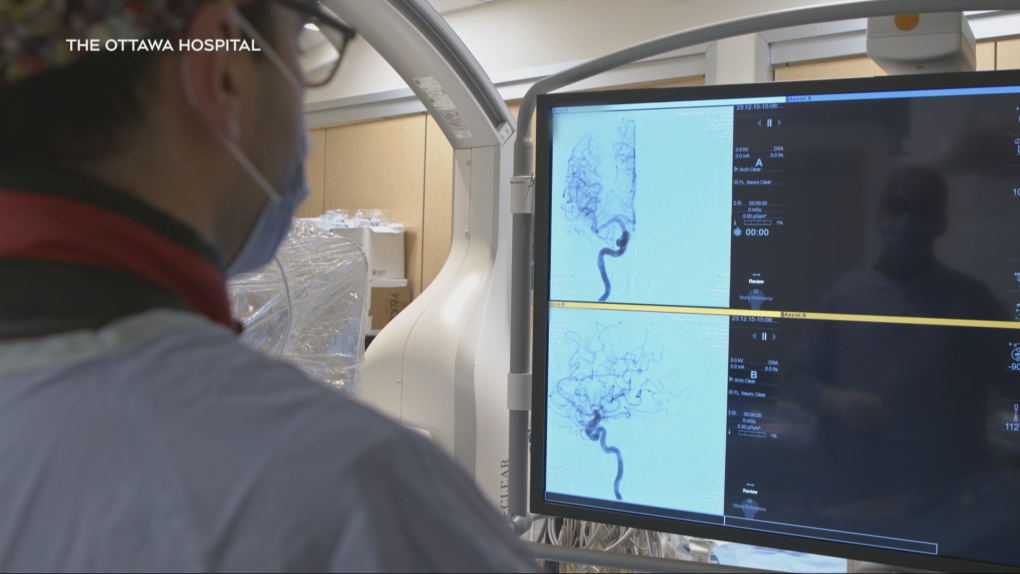UW startup achieves a world’s first with tiny camera used in brain surgery
A tiny camera was recently used in a procedure in Ottawa to help diagnose and treat a patient who suffered multiple strokes, making it a world’s first.
The device was developed by Kitchener company, Vena Medical, which started out of the University of Waterloo’s startup incubator Velocity.
The camera is barely wider than a strand of hair, which is helpful as it weaves through tight spaces in the body.
“About a third of a millimeter in diameter. So it's very, very small. The next smallest is three to four times the size of that,” said Michael Phillips, the company’s co-founder and CEO.
 Vena Medical's camera is inserted into a tube.
Vena Medical's camera is inserted into a tube.
Phillips and his other co-founder, Phil Cooper, wanted to fill an industry gap in the medical field.
Between the two of them, the duo has seven physicians in their immediate families.
They said, historically, it's been difficult to see exactly what’s going on inside veins or arteries.
“Physicians were relying on fluoroscopy, which is essentially like using a 2D X-ray movie to perform these procedures,” said Cooper.
Those limitations have existed - until now.
A medical technology milestone was recently marked at The Ottawa Hospital when physicians were able to see live video, in full colour, from inside the vessels of a patient’s brain while doing surgery. At the same time, they were able to diagnose and treat them after suffering from multiple strokes.
That had never been done before.

“If it's black and white, you can't get as much information. But for clot type, whether the clot is red or whether it's white, basically red blood cell rich or fibrin rich, that has a direct impact on which technique you should choose to treat that patient,” Phillips said.
Due to the camera’s size, the potential exists to expand its scope beyond just treating stroke patients.
“We're starting off with neurovascular procedures. So that's things like stroke, carotid artery disease, aneurysms,” Cooper said.
The cameras are disposed after one use, which is common with devices that come in contact with blood.
As for what’s next, the hope is to roll the camera out across Canada.
“There’s definitely nothing like this,” Phillips said.
CTVNews.ca Top Stories

Kamala Harris endorsement excites Democrats, but what could it mean for Canada?
U.S. President Joe Biden's endorsement of Vice-President Kamala Harris as his possible replacement stirred excitement among Democrats, but one analyst has concerns about what a potential Harris presidency would mean for Canada.
Four suicides in New Zealand linked to Ontario's Kenneth Law
New Zealand's coroner has ruled that four of its citizens died after ordering products from an Ontario man who is facing murder charges for selling poisonous substances.
These are the four leading vice-presidential picks for Kamala Harris' campaign
No one knows the importance of selecting the right running mate better than Vice President Kamala Harris.
2 Albertans accused of threatening to kill Trudeau, Freeland, Singh
Men from Edmonton and Calgary are accused of threatening to kill some of Canada's top government leaders.
Here's why cyber experts say Canada failed in its response to the CrowdStrike outage
Millions of computers went offline around the world on Friday after a faulty CrowdStrike software update impacted airlines, hospitals, banks and broadcasters. Cyber experts say Canada failed in its response compared to other countries, showing it's vulnerable and ill-prepared for future attacks.
Toronto woman charged with voyeurism after taking 'intimate' photos during massage: police
A Toronto woman who allegedly took 'intimate' photos of an individual who was getting a massage has been charged with voyeurism, police say.
U.S. drops planned regulations for dogs crossing border from rabies-free countries
The U.S. Centers for Disease Control will not require onerous forms for dog owners crossing the border from Canada this summer.
Do you want to be happier? Here are 5 habits to adopt
If you look around at your friends and family — and even at yourself — it is apparent that some people perceive the glass to be half full, while others view it as half empty. Which habits can you adopt to increase your level of happiness? A social psychologist has these five tips.
Police identify body of man who washed ashore on Nova Scotia's Sable Island
Nova Scotia RCMP has identified one of the bodies found on Sable Island earlier this month.





























